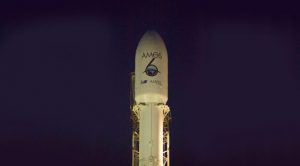
SpaceX announced on 2 January 2017 that it had identified the cause of the catastrophic explosion of its Falcon-9 space launch vehicle (SLV) containing Israeli company Spacecom’s AMOS-6 communications satellite on 1 September 2016.
SpaceX and U.S. government and space industry experts believe that the explosion occurred due to the failure of at least one of the Falcon-9’s composite overwrapped pressure vessels (COPV’s) containing helium inside of the liquid oxygen tank of the SLV’s second stage. This resulted in the complete destruction of the SLV and its AMOS-6 payload in a matter of 93 milliseconds from the moment the COPV failed through to the destruction of the second stage.
The SpaceX statement on its findings described the failure as follows:
The accident investigation team worked systematically through an extensive fault tree analysis and concluded that one of the three composite overwrapped pressure vessels (COPVs) inside the second stage liquid oxygen (LOX) tank failed. Specifically, the investigation team concluded the failure was likely due to the accumulation of oxygen between the COPV liner and overwrap in a void or a buckle in the liner, leading to ignition and the subsequent failure of the COPV.
Along with SpaceX and other space industry experts, the accident investigation team comprised experts from the U.S. Federal Aviation Authority (FAA), the U.S. Air Force, the U.S. space agency National Aeronautics and Space Administration (NASA), and the National Transportation Safety Board (NTSB).
The Falcon-9 explosion on 1 September 2016 completely destroyed Spacecom’s AMOS-6 satellite, jeopardising the planned buyout of Spacecom by Chinese company Beijing Xinwei Technology Group Co., Ltd. Since the explosion talks between Spacecom and Beijing Xinwei have resumed over a new buyout deal.
In the meantime, Spacecom has contracted with Boeing Satellite Systems International for AMOS-17, a replacement satellite for AMOS-6 that will be launched in 2019. Until then, Spacecom has agreed with AsiaSat to use the ASIASAT-8 satellite as a gapfiller.
SpaceX also announced that it will resume launches of its Falcon-9 SLV as of 8 January 2017.
Original published at: http://spacewatchme.com/2017/01/spacex-cites-technical-failure-amos-6-launch-blast/
 SpaceWatch.Global An independent perspective on space
SpaceWatch.Global An independent perspective on space

